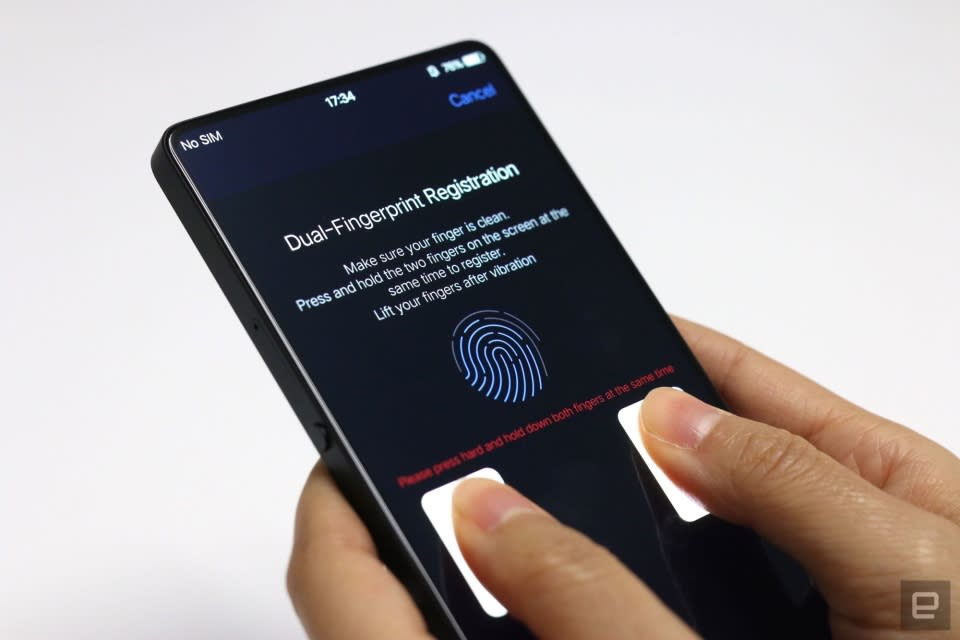The chaos of unlocking your phone in 2018
Fingerprints, voices, faces, eyes, double fingerprints.
PIN codes and patterns are passe. MWC 2018 kicked off with the usual fanfare of a major flagship launch -- the Galaxy S9. With it, Samsung introduced its own, new, face unlock feature. Google may have added the feature to Android many years ago, but it seems technology has progressed enough to make it worth resurrecting by Samsung -- with some extra biometric backup. The House of Galaxy might have also felt the competitive tug of Apple's surprisingly slick Face ID unlock feature on the iPhone X.
Samsung wasn't the only company innovating when it comes to how we get our smartphone working. And it's not just the thousand-dollar flagships, either. Biometrics are here in a big way, although no-one seems to know which method's best. How many of these techniques will last to see 2020?
Samsung Galaxy S9's "Intelligent Scan"

Samsung's new flagship devices have both a front-facing 8-megapixel camera and an iris scanner. These work in tandem for "Intelligent Scan", which combine the secure identifying nature of your eye's unique makeup with a camera that detects your face. Samsung believes its iris scanner isn't as effective in bright light as it is in the dark, thus it's included the more traditional camera backup this time. With the new system, the S9 tries to sign you in with your eyes by default, but when that fails, it will use facial recognition. Samsung says the technology is learning-based, which means it should improve its ability to latch on to your face as you continue to use it.
This is the marquee feature for Samsung when it comes to ID and security: it plans to use this like Apple does for app purchases and feature logins. The company says Samsung Pass will be up first, offering identification for websites through its own Internet app. (Which means you'd have to use that over, say, Chrome on Android.)
We're still putting this Intelligent Scan feature to the test ahead of reviewing the device in full, but remember; facial scans don't offer the security necessary for keeping your phone locked. Samsung has also kept its fingerprint sensor, although it thankfully moved it further away from the camera this time.
To be honest, the company's packed nearly every security option in here. You can unlock its newest phones with a pattern, PIN, or password; the iris scanner, fingerprint scanner or face recognition; and Intelligent Scan (that aforementioned blend of iris and face scanning).

Vivo's hidden dual fingerprint scanner
Vivo's in-screen fingerprint scanner offers a glimpse at the future of all-screen phone interfaces: No giant button needed. While we saw that back in January, at MWC this week the company bested, well, itself. Compared to the X20 Plus, which had a single spot for on-screen fingerprint verification, the new concept device has an entire quarter of the screen to do the deed. It's a big enough space that it can also handle dual fingerprint scanning -- if you wanted that extra coating of security.

Vivo's using ultrasound sensors that can apparently read your prints across a bigger area beneath the screen. (In comparison, the last model did the same scanning trick with a tiny camera sensor, but that's something apparently only possible with OLED screens).
When Engadget Senior Editor, Chris Velazco, tested it out in person, the tech wasn't exactly flawless, taking multiple attempts to unlock with a fingerprint. It's also folded into a concept phone -- one with a pop-out selfie cam, no less. The chances of an identical phone appearing in the west are pretty slim.
Alcatel's cheap smartphones still pack face recognition and fingerprint scanners

Not all phones are born flagships, but that's no longer a good enough excuse not to upgrade from a PIN you made back when Brangelina was a thing. The Alcatel 5 might be a middleweight in spec sheet terms, but it still folds in both a fingerprint sensor and face unlock features. It doesn't sound particularly foolproof: the "Face Key" will attempt to detect 100 points on the user's face to verify, so it's possible photos might be enough to trip it up. Still, the unlock feature was swift enough during our brief time with it earlier this week. Somehow, you can even go cheaper: the Alcatel 3 slides in just under 200 Euros.
Other options
Also announced this week, LG's V30S ThinQ isn't a huge leap beyond last year's V30, and it doesn't pack any new methods to unlock. It does, however, offer voice unlock, something that snuck into the debut V30 last year but hasn't been adopted on any other devices, as far as we can tell. It's not hard to see why: Asking Google Assistant / Siri questions in public is hard enough, let alone with the frequency we all unlock our phones. Still, it's yet another method to add to the pile.
We'll throw in a quick hat-tip to Apple and Face ID. Its True Depth camera system -- that's why there's a notch -- is made up of a bunch of sensors (ambient light, infrared and proximity) that detect your face, even in the dark. It offers a more secure version of simple camera-based face recognition and is surprisingly smooth and hassle-free -- so much that Huawei is looking to fold in similar tech into its next phone but better, of course.
For now, it's still a mess of techniques out there, and you get what you pay for when it comes to reliability and security. It might, however, be a sign to upgrade your smartphone security.
Catch up on the latest news from MWC 2018 right here.

















